January Garden Priorities for your Los Angeles Regenerative Garden
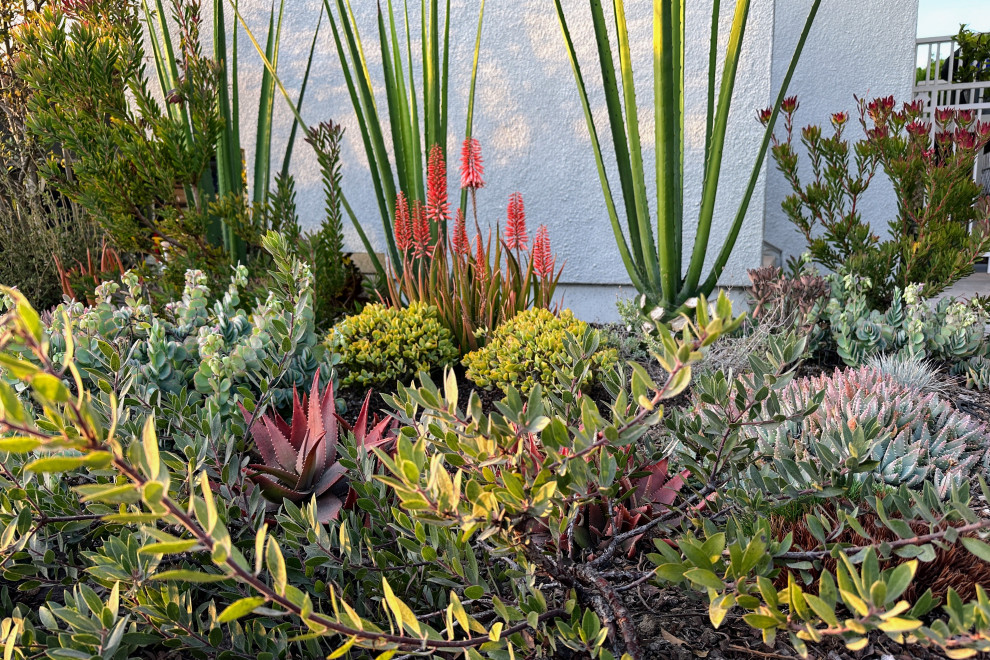
Winter blooming aloe and California native manzanita in a pollinator friendly garden designed for residents in the Southbay of Los Angeles
Regenerative Coastal California Gardening Guide
By Mandy Staal
California Certified Nursery Professional, California Naturalist, Certified California Native Plant Landscaper
Weather and Climate
Happy New Year! Though we had a dry December, we are hoping to start off 2025 with at least 1.5” of rain this month. On a rainy day you can clean your garden shed or order some specialty seeds to plan ahead. On a clear day, get some vitamin D and work on some of these garden tasks.
Blooms, Color, and Pollinators
Pollinator-friendly garden design in San Pedro, Long Beach, Torrance and Palos Verdes
Pink splashes the native garden this month with lots of nectar for hummingbirds.
manzanita (Arctostaphylos spp.)
currant (Ribes spp.)
gooseberry (Ribes speciosum)
silk tassels (Garrya elliptica)
hummingbird sage (Salvia spathacea)
New Zealand tea tree (Leptospermum scoparium)
aloe (Aloe spp.)
lilac vine (Hardenbergia violacea)
mountain marigold (Tagetes lemonii)
grevillea (Grevillea spp.)
lion’s tail (Leonotis leonurus)
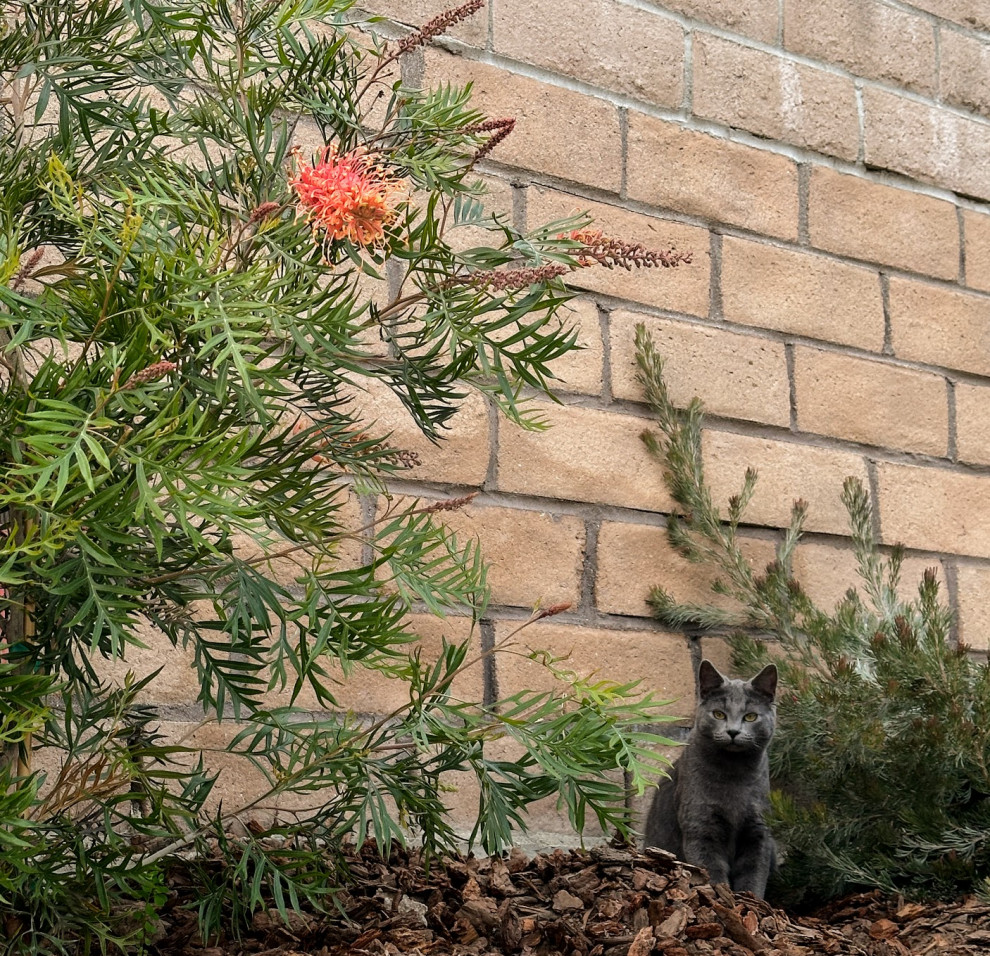
Blooms start to open on this grevillea in a pollinator friendly garden in Los Angeles
Harvests
Edible gardens in San Pedro, Long Beach, Torrance and Palos Verdes
These plants may be ready for harvest in your garden depending on when you planted:
- broccoli
- beets, carrots, kohlrabi, turnips
- peas
- celery
- lettuce
- various herbs
Cut and come again:
- Harvest the lower older leaves of lettuce first to allow it to keep growing
- Harvest broccoli when the buds are full but tight. Cut below the bud but right above the next leaf to encourage another crop.
- Harvest cabbage when the heads are full and firm. Cut just below the head, allowing the bottom leaves to remain and produce another crop.
- When hoping for another crop after the first harvest, feed plants with organic fertilizer or add compost.
Pro Tip for extra beautiful and tasty cauliflower: When the white head of cauliflower has grown to about the size of an egg, tie the larger leaves around it with rubber bands or twine to protect it from discoloration and developing a bitter taste. This is called blanching. Take care to do this when the plant is dry so you don’t trap moisture in. Untie it to check if it's ready to harvest. The goal is to harvest it when the curd is full but hasn’t opened into flowers yet. Unlike broccoli, cauliflower won’t produce another crop so remove the plant and compost it.
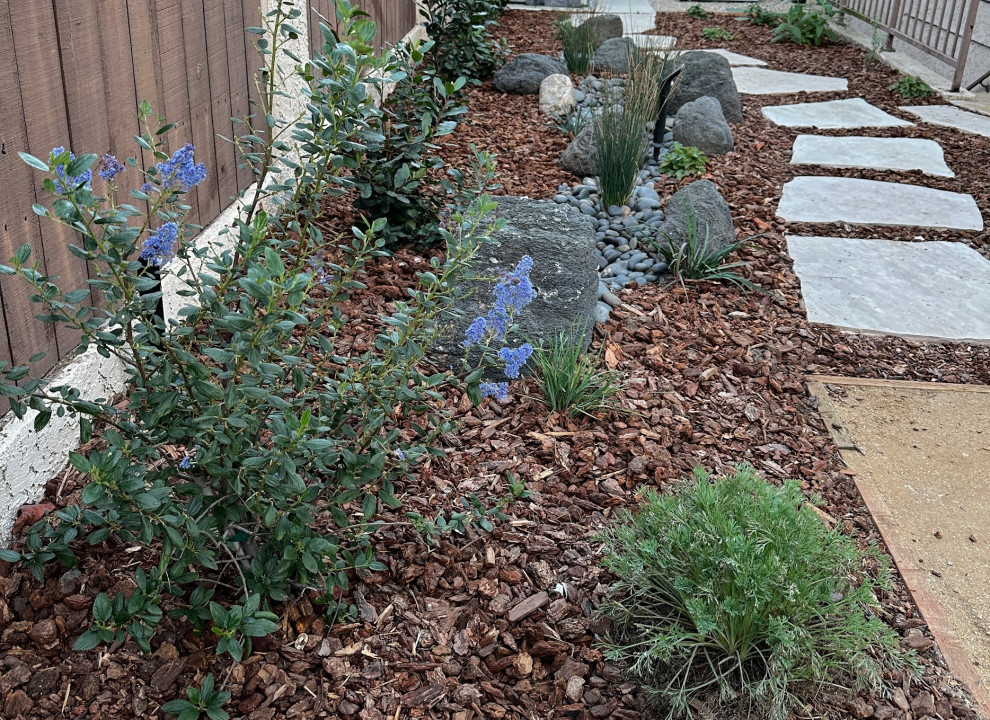
An early blooming ceonothus shines in this Southbay rain garden.
Planting
California native plant gardens in San Pedro, Long Beach, Torrance and Palos Verdes
- For native seed starting, sow acorns, iris, toyon and, of course, wildflowers. Get a pack of native wildflower seeds from Tree of Life Nursery, Plant Material, Artemisia Nursery, or Theodore Payne Nursery. You can usually find California poppy seeds at most local nurseries too.
- Mix your wildflower seeds with your native soil and a bit of water in a container before broadcasting to reduce birds nibbling on them. Or you can lightly rake them into the soil.
- You can continue to plant in the rainy season to develop robust root systems that will lead to thriving, lush plants in the spring. Just don't disturb the soil until a few days after a good rain. It can lead to compaction if the soil is too moist.
- Plant bare root roses, berries, trees, artichokes, asparagus, and onions now available at local nurseries
- Cool season veggies like broccoli, brussel sprouts, cabbage, cauliflower, celery, lettuce, peas, and swiss chard can continue to be planted Seeds of beets, carrots, lettuce, peas, radishes, turnips, and herbs can be sown
- Plant strawberries, and annual flowers
- Buy specialty seeds so you can be ready to sow in the spring. Some examples of good seed sources online are Baker Creek Heirloom Seeds, Seed Savers Exchange, Row 7 Seeds, and Johnny’s Seeds
- Choose varieties bred for disease resistance for lower maintenance or dwarf varieties for small space gardening
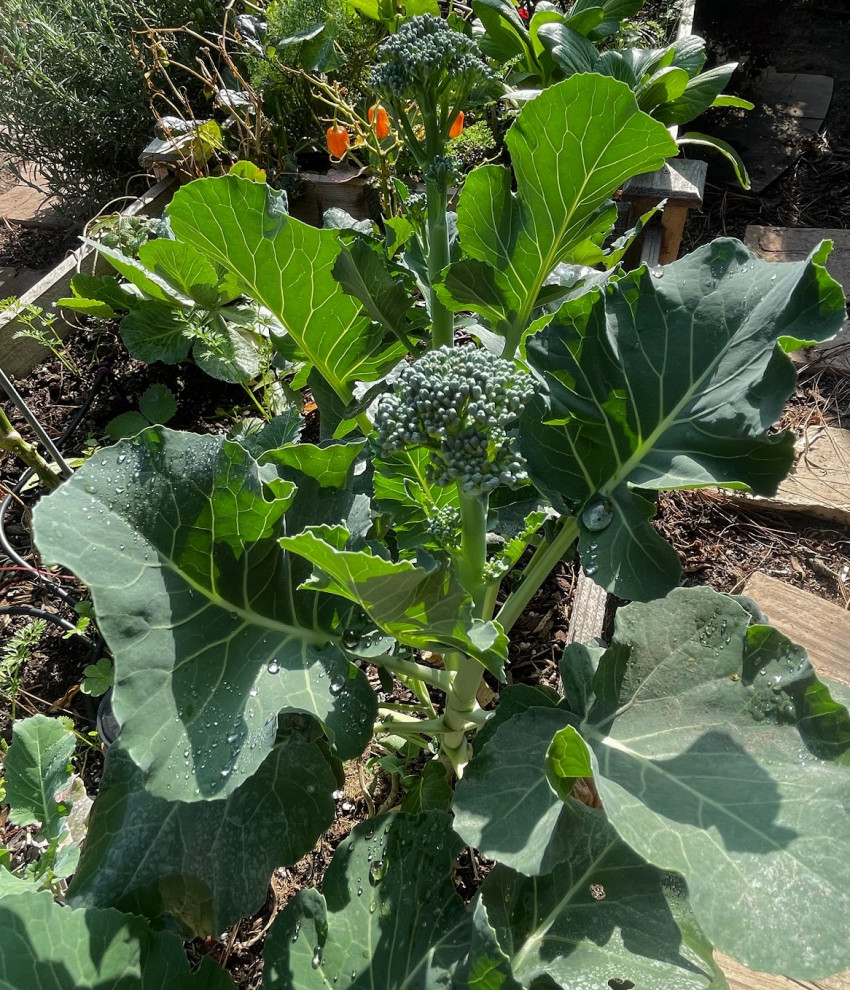
Broccolini is almost ready to harvest in this organic edible garden in San Pedro.
Watering
Waterwise garden design San Pedro, Long Beach,Torrance and Palos Verdes
With cool temperatures and anticipated rain, most plants don’t need frequent water. Be sure to adjust irrigation to be even less frequent, if you haven’t already.
- Set your irrigation to manual once the rain starts so precious water is not wasted.
- In an established native garden (1 year or older), there’s no need for supplemental irrigation if it has rained more than 1.5” that month.
- If it doesn’t rain 1.5” this month, be sure to give native plants a deep soak to imitate the rainy season.
- Fruit trees appreciate a deep soak every two weeks depending on your soil and how much fruit is on the tree.
- Raised beds and pots with new plantings prefer water every other day. Those with more established plants prefer water twice a week.
Keep in mind these estimates are highly variable according to plant needs, soil, sun, wind, etc. If you are in doubt about your watering schedule and amount, check the soil moisture at least 4 inches deep for trees and shrubs and 2 inches deep for annuals.
Pruning
Permaculture garden design San Pedro, Long Beach, Torrance and Palos Verdes
It’s fruit tree pruning time!
- Prune your dormant fruit trees and vines once their leaves have dropped. Remove dead wood, crossed and crowded branches, and open the structure of the canopy to allow airflow and more sun exposure. Remove watersprouts, the vertical shoots coming from the bottom of the trunk. If you want to maintain the tree size, reduce the overall height or width of the tree by no more than a third. Here are some resources for more information on this complex topic: Greg Alder’s Advice and a video of Tom Spellman’s pruning methods.
- Skip the prune sealer. Prune sealer can trap moisture and cause rotting. Healthy trees have their own immune systems that are more effective at protecting themselves from infection without the side effects. Allow your prune cuts to scab over on their own.
- Contrary to popular belief, you can skip the dormant spray. Leaf curl may look horrifying but it doesn’t hurt your trees or affect fruit production. Again, healthy trees have a very effective immune system that will fight infections for you. They will eventually drop infected leaves. For more information related to dormant sprays and disease prevention we recommend reading this article by Greg Alder.
- Make sure you sanitize pruners with alcohol between different plants to prevent spreading diseases.
- Prune your natives except for winter or early spring bloomers like ceanothus and manzanita.
- Cut back Matilija poppies, milkweed, fuchsias, daisies, lavender and other perennials if you haven’t already
- Cut back roses. Many resources tell you to prune roses in the spring which is true for areas with colder winters, but in Southern California the best time to prune them is this month or next month. See this UC master gardener article for a comprehensive guide.
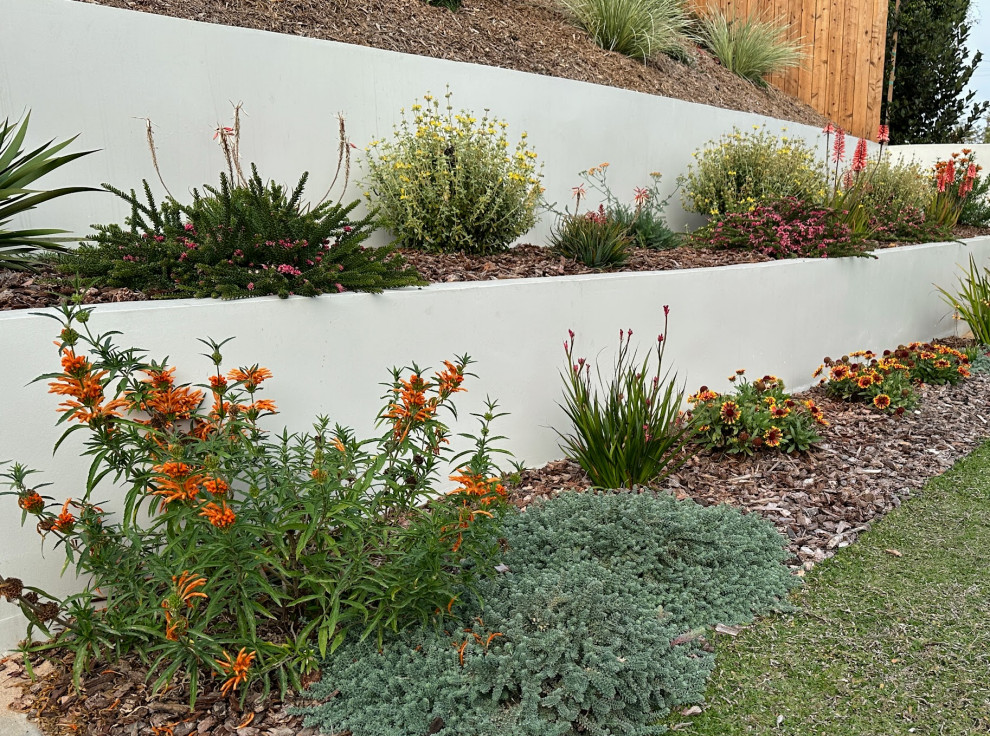
Nectar for hummingbirds is abundant in this waterwise garden with lion’s tail, grevillea, kangaroo paw, jerusalem sage, gaillardia, and aloe in Torrance.
Fertilizing
Organic garden design San Pedro, Long Beach, Torrance, and Palos Verdes
There is not much need for fertilizing when most plants aren’t actively growing. We don’t need to apply excess fertilizer that may get washed into our watersheds by the rain. That being said, for your veggies and herbs you can continue adding compost or an organic fertilizer made from food scraps without any synthetic additives (such as Dr. Earth brand) every 4-6 weeks for improved yield.
Mulching and Compost
Eco-friendly garden design San Pedro, Long Beach, Torrance and Palos Verdes
- Add compost and mulch if you haven’t already in fall to improve soil quality. It will start breaking down nicely with the rain. These organic materials feed soil organisms like earthworms and fungi which then help feed plants. You may even get some cute mushrooms sprouting up post-rain!
- Make sure the crown (where the trunk meets soil and tapers) of trees and shrubs is not buried in mulch or compost as this can cause rot.
- Leave the leaves! No need to rid plants of their natural mulch with leaf blowers.
- Adding acidic planting mix to acid loving plants like berries, azaleas, and camellias will help them stay healthy and green through the winter. If you have pine needles, oak leaves, and/or coffee grounds available, these can alternatively be applied around acid loving plants (in moderation!) as a natural method to begin to improve acidity in soil.
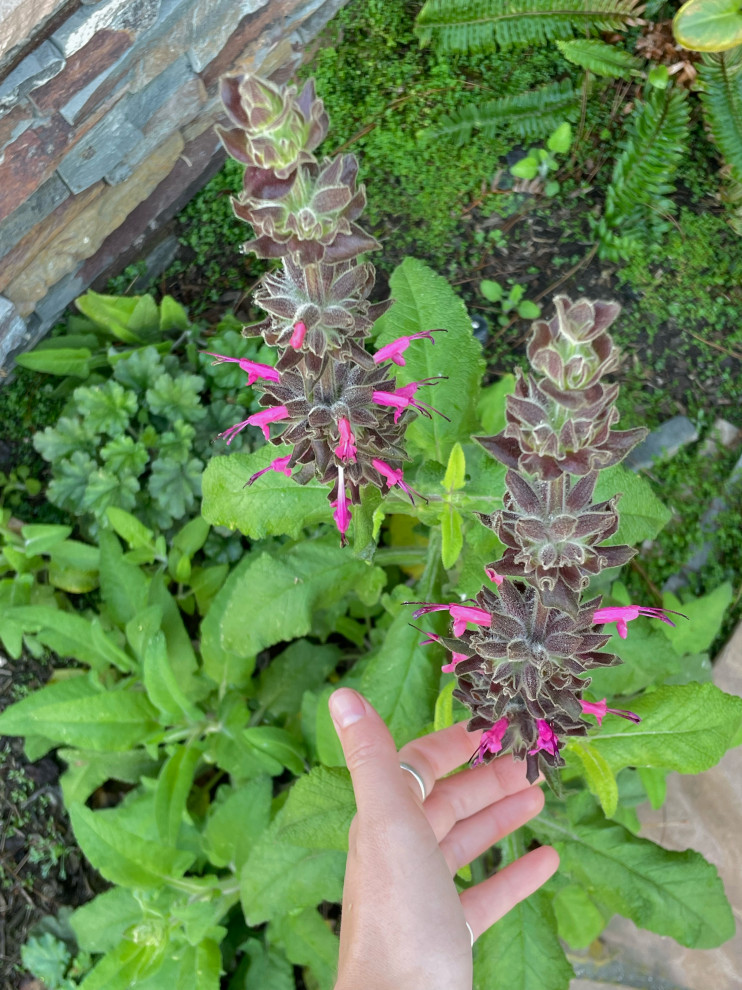
Hummingbird sage starting to bloom in a California native garden in Torrance.
Pests and Diseases
Sustainable garden design San Pedro, Long Beach, Torrance and Palos Verdes
- Gophers are more active when the soil is moist. If you have gophers in your area, protect your transplants’ roots with chicken wire or gopher baskets when you plant. Luckily many native plants are not the gophers’ favorites.
- Keep an eye out for wilting or diseased plants. Powdery mildew or downy mildew may be culprits this time of year, but thankfully they are not deadly.
- This is best treated by removing diseased leaves. (Copper fungicides which are often recommended may be necessary in extreme cases, but we generally recommend avoiding in habitat gardens as these types of sprays can be detrimental to birds, bees and other critters, especially when sprayed near blooms or during feeding times of day.)
- To decrease risk of disease, thin branches to allow good circulation and air to flow through, reducing moisture sitting on leaves. Sanitize your pruners with alcohol spray in between cuts to prevent spreading infection.
- Make sure your spray irrigation isn’t going off too late in the afternoon as this can allow moisture to sit on leaves too long and activate disease overnight. Ensure plants have optimal time to dry out during the day and between watering events where possible.
- Remember near the coast, mildew is part of life. While it can be an ugly nuisance, it usually won’t kill the plant when dealt with aggressively through the measures detailed above.
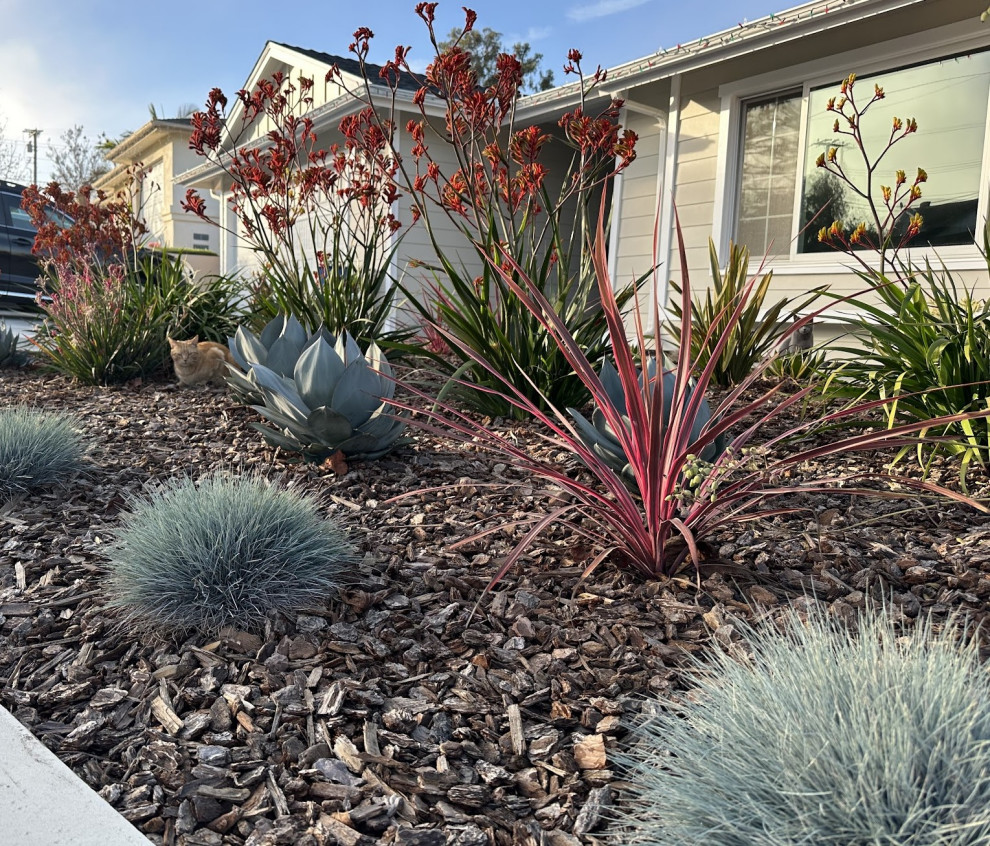
Kangaroo paw blooming alongside agave, blue fescue, and cordyline in a residential waterwise garden in Torrance.
Gratitude
As we step into a new year, let’s take a moment to ground ourselves in the natural world and embrace the therapeutic joys of gardening. January offers a precious pause – a time of dormancy and rest – before spring bursts forth with its energy and renewal. This is our chance to reflect, recharge, and set meaningful intentions for another year on this beautiful planet.
We are deeply grateful to our incredible team, cherished clients, and supportive friends for helping us bring more beauty, connection, and purpose into the world. It’s a joy to visit the thriving gardens we’ve created together and witness their impact – nurturing caretakers, delighting neighbors, and providing havens for wildlife.
Here’s to another year of growth, discovery, and creation. May your days be filled with smiles, inspiration, and the quiet magic of plants.
With gratitude and best wishes,
Sara, Mandy & the Pachamama Team
References:
“California Native Gardening: A Month by Month Guide” by Helen Popper
“Southern California Gardening A Month by Month Guide” by Pat Welsh
